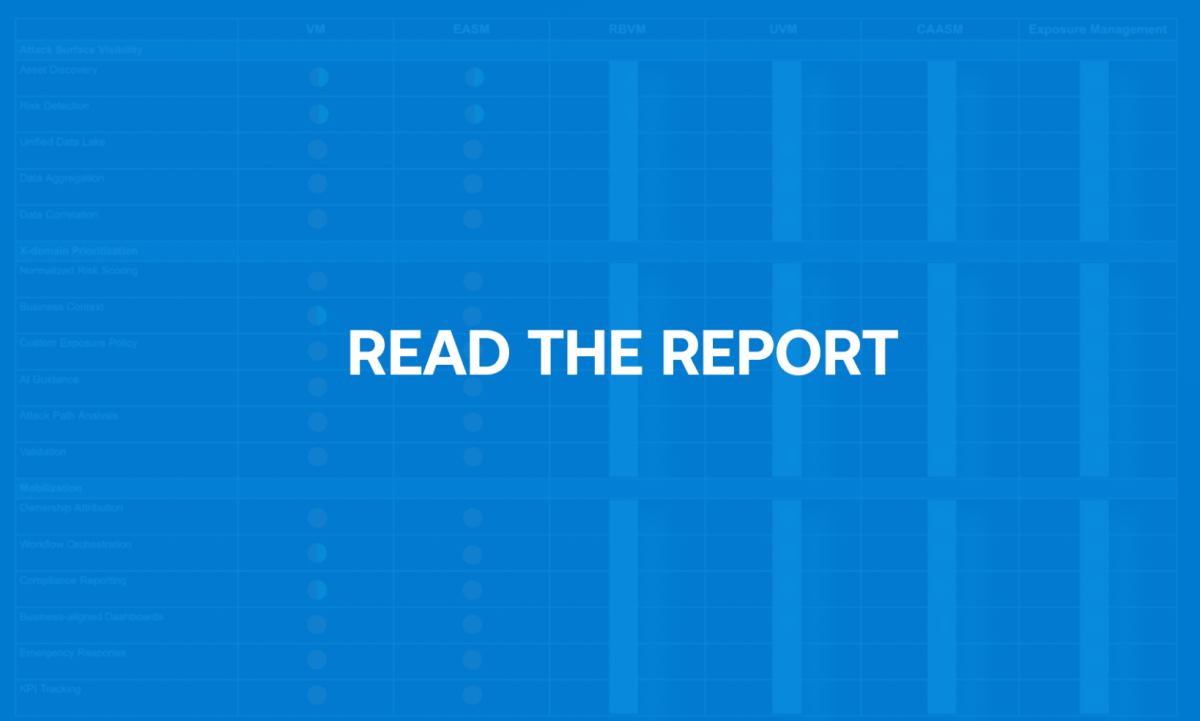Guide
Choosing the right Exposure Management Platform
Get the free guide to understand critical features, criteria, and things to ask.

What’s inside this buyer’s guide?
In today’s complex cybersecurity landscape, understanding where your organization is truly exposed is more critical than ever. This Buyer’s Guide to Exposure Management Platforms—also known as Exposure Assessment Platforms (EAPs) or Continuous Threat Exposure Management Platforms (CTEM platforms) — helps security leaders evaluate solutions that go beyond traditional attack surface management and risk assessment tools by prioritizing business impacting exposures.
This guide will answer important questions:
- What is exposure and exposure management?
- What role do exposure management platforms play in the security continuum?
- How do exposure management platforms differ from other security tools?
- What features and selection criteria are important?
- What specific questions should you ask platform providers?
- How should you get started?
Download the guide and gain the clarity to invest wisely, reduce cyber risk more effectively, and maximize the value of your platform investment.
Distinguishing exposure management from other security disciplines
Industry analysts often describe exposure management as the natural evolution of vulnerability management, as it extends visibility beyond traditional IT assets and vulnerabilities to address all forms of assets and risk, including misconfigurations and exploitable identities and permissions. In doing so, it not only unifies multiple security solutions in one, it adds critical relationship mapping to deliver deep exposure context not available from individual point solutions.
For the purpose of this guide, we define and compare the market segments and solutions most commonly recognized as foundational to exposure management. These include:
- Vulnerability management: Identifies IT assets and prioritizes software vulnerabilities using standard industry models such as CVSS.
- Risk-based vulnerability management (RBVM): Identifies IT assets and enhances prioritization using risk-based scoring that factors in exploitability and asset criticality.
- External attack surface management (EASM): Identifies external-facing assets and their associated risks that are often an initial target of attackers.
- Cyber asset attack surface management (CAASM): Aggregates asset information from existing tools providing a centralized view of assets across the attack surface.
- Unified vulnerability management (UVM): Aggregates findings from existing tools providing a centralized view of risk across the attack surface.
- Exposure management: Discovers and aggregates asset and risk data across the attack surface and existing tools to provide a unified, contextual view of assets and exposure, exploitable attack paths leading to crown jewels, and the potential business impact for prioritized action.
Download the buyer’s guide to learn more

Gain a detailed understand of what key features are covered by exposure management platforms vs other security tools. Download the buyer's guide for the complete report.
Platform features and selection criteria
As a general rule, exposure management platforms provide three core functions:
- Visibility to illuminate the attack surface, including important relationships
- Prioritization to separate potential business-impacting exposure from noisy findings
- Mobilization to optimize communication and speed remediation of exposure
This guide dives into each of the three core functions and explains the important features exposure management platforms provide to support them. We also distinguish how other solutions compare in terms of feature parity.
Unifying attack surface visibility
Complete visibility across the extended attack surface, including internally facing and externally facing assets, is foundational to an effective exposure management program. Without a comprehensive, unified view of all assets — across on-prem, cloud, OT, IoT, applications and identities — security teams are blind to unknown risks and hidden attack paths that are the target of attackers.
There are several ways exposure management platforms help document the attack surface, including native asset discovery, risk scanning, data aggregation and relationship mapping between assets, identities and risks. This guide details why these are important when selecting a platform and what specifically to look for.
Prioritizing exposure across domains
Prioritizing exposures is crucial for an effective exposure management program. Not all risks are created equal and security teams can become overwhelmed by noise if they lack clear guidance on what to fix first.
Exposure management platforms go beyond basic risk scoring by individual finding, providing rich relationship context and prioritization capabilities across domains. Exposure management platforms should provide normalized risk scoring, business context, custom exposure policy, AI guidance, attack path analysis, and exposure validation. Download the buyer’s guide to learn more.
Mobilizing resources and investments
Once exposures are prioritized, effective mobilization is essential to translate insights into action and reduce risk. This involves streamlining remediation processes and ensuring accountability across teams.
Exposure management platforms help you mobilize resources and investments, by providing key capabilities, including ownership attribution, workflow orchestration, exposure reporting, exposure dashboards, emergency response, and KPI tracking. This buyer’s guide details what to look for in each of these areas.
- Tenable Attack Surface Management
- Tenable Cloud Security
- Tenable Identity Exposure
- Tenable One
- Tenable OT Security
- Tenable Vulnerability Management
- Tenable Web App Scanning